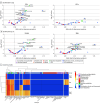Environmental Toxicant Exposure and Depressive Symptoms
- PMID: 38958973
- PMCID: PMC11222999
- DOI: 10.1001/jamanetworkopen.2024.20259
Environmental Toxicant Exposure and Depressive Symptoms
Abstract
Importance: Recognizing associations between exposure to common environmental toxicants and mental disorders such as depression is crucial for guiding targeted mechanism research and the initiation of disease prevention efforts.
Objectives: To comprehensively screen and assess the associations between potential environmental toxicants and depressive symptoms and to assess whether systemic inflammation serves as a mediator.
Design, setting, and participants: A total of 3427 participants from the 2013-2014 and 2015-2016 waves of the National Health and Nutrition Examination and Survey who had information on blood or urine concentrations of environmental toxicants and depression scores assessed by the 9-item Patient Health Questionnaire (PHQ-9) were included. Statistical analysis was performed from July 1, 2023, to January 31, 2024.
Exposures: Sixty-two toxicants in 10 categories included acrylamide, arsenic, ethylene oxide, formaldehyde, iodine, metals, nicotine metabolites, polycyclic aromatic hydrocarbons, volatile organic compound (VOC) metabolites; and perchlorate, nitrate, and thiocyanate.
Main outcomes and measures: An exposome-wide association study and the deletion-substitution-addition algorithm were used to assess associations with depression scores (PHQ-9 ≥5) adjusted for other important covariates. A mediation analysis framework was used to evaluate the mediating role of systemic inflammation assessed by the peripheral white blood cell count.
Results: Among the 3427 adults included, 1735 (50.6%) were women, 2683 (78.3%) were younger than 65 years, and 744 (21.7%) were 65 years or older, with 839 (24.5%) having depressive symptoms. In terms of race and ethnicity, 570 participants (16.6%) were Mexican American, 679 (19.8%) were non-Hispanic Black, and 1314 (38.3%) were non-Hispanic White. We identified associations between 27 chemical compounds or metals in 6 of 10 categories of environmental toxicants and the prevalence of depressive symptoms, including the VOC metabolites N-acetyl-S-(2-hydroxy-3-butenyl)-l-cysteine (odds ratio [OR], 1.74 [95% CI, 1.38, 2.18]) and total nicotine equivalent-2 (OR, 1.42 [95% CI, 1.26-1.59]). Men and younger individuals appear more vulnerable to environmental toxicants than women and older individuals. Peripheral white blood cell count mediated 5% to 19% of the associations.
Conclusions and relevance: In this representative cross-sectional study of adults with environmental toxicant exposures, 6 categories of environmental toxicants were associated with depressive symptoms with mediation by systemic inflammation. This research provides insight into selecting environmental targets for mechanistic research into the causes of depression and facilitating efforts to reduce environmental exposures.
Conflict of interest statement
Figures



References
-
- GBD 2019 Mental Disorders Collaborators . Global, regional, and national burden of 12 mental disorders in 204 countries and territories, 1990-2019: a systematic analysis for the Global Burden of Disease Study 2019. Lancet Psychiatry. 2022;9(2):137-150. doi:10.1016/S2215-0366(21)00395-3 - DOI - PMC - PubMed
-
- Evans-Lacko S, Aguilar-Gaxiola S, Al-Hamzawi A, et al. . Socio-economic variations in the mental health treatment gap for people with anxiety, mood, and substance use disorders: results from the WHO World Mental Health (WMH) surveys. Psychol Med. 2018;48(9):1560-1571. doi:10.1017/S0033291717003336 - DOI - PMC - PubMed
-
- World Health Organization . World misses most 2020 mental health targets; extension of WHO Mental Health Action Plan to 2030 provides new opportunity for progress. October 8, 2021. Accessed December 29, 2023. https://www.who.int/news/item/08-10-2021-who-report-highlights-global-sh...
Publication types
MeSH terms
Substances
LinkOut - more resources
Full Text Sources
Medical

